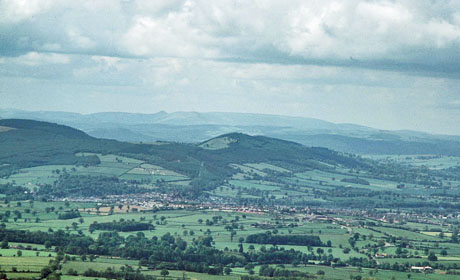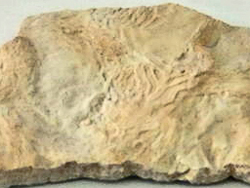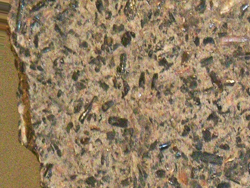Ludlow
Shropshire, England

In 1832 Dr Thomas Lloyd, the Ludlow doctor and amateur geologist, met Roderick Murchison at Ludford Corner to study the rocks exposed along the River Teme and on Whitcliffe, advancing Murchison's theory for a Silurian System that he was to publish in 1839.
 Immediately above the topmost layer of the marine rock sequence forming Murchison's Silurian period was a thin layer of dark sand containing numerous remains of early fish, especially their scales, along with plant debris, spores and microscopic mites. In contrast to the underlying sediments of the Ludlow Series which were deposited in a shallow warm sea some 400 million years ago, the Ludlow Bone Bed represents terrestrial (land) conditions and thus a fundamental change in the landscape.
Immediately above the topmost layer of the marine rock sequence forming Murchison's Silurian period was a thin layer of dark sand containing numerous remains of early fish, especially their scales, along with plant debris, spores and microscopic mites. In contrast to the underlying sediments of the Ludlow Series which were deposited in a shallow warm sea some 400 million years ago, the Ludlow Bone Bed represents terrestrial (land) conditions and thus a fundamental change in the landscape.
 At the time, this was believed to be the earliest occurrence of life on land. Murchison thus took the Ludlow Bone Bed as the base of his Devonian Period, although over a century later this boundary was to be moved a little higher, the overlying rocks being ascribed to the Pridoli.
At the time, this was believed to be the earliest occurrence of life on land. Murchison thus took the Ludlow Bone Bed as the base of his Devonian Period, although over a century later this boundary was to be moved a little higher, the overlying rocks being ascribed to the Pridoli.
The science of geology has taken a number of local names from these studies and now applies them worldwide, in recognition of the importance of this area to scientific understanding, for example Ludlow Series and Whitcliffe Formation.

The site is now an SSSI (Site of Special Scientific Interest) and still attracts international studies. The geological period of the Ludlow epoch is named after the town.
Text: Wikipedia
Nominated by: Geraint Owen @gerainthowen